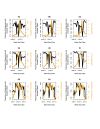Guess who's not coming to dinner? Evaluating online restaurant reservations for disease surveillance
- PMID: 24451921
- PMCID: PMC3906695
- DOI: 10.2196/jmir.2998
Guess who's not coming to dinner? Evaluating online restaurant reservations for disease surveillance
Abstract
Background: Alternative data sources are used increasingly to augment traditional public health surveillance systems. Examples include over-the-counter medication sales and school absenteeism.
Objective: We sought to determine if an increase in restaurant table availabilities was associated with an increase in disease incidence, specifically influenza-like illness (ILI).
Methods: Restaurant table availability was monitored using OpenTable, an online restaurant table reservation site. A daily search was performed for restaurants with available tables for 2 at the hour and at half past the hour for 22 distinct times: between 11:00 am-3:30 pm for lunch and between 6:00-11:30 PM for dinner. In the United States, we examined table availability for restaurants in Boston, Atlanta, Baltimore, and Miami. For Mexico, we studied table availabilities in Cancun, Mexico City, Puebla, Monterrey, and Guadalajara. Time series of restaurant use was compared with Google Flu Trends and ILI at the state and national levels for the United States and Mexico using the cross-correlation function.
Results: Differences in restaurant use were observed across sampling times and regions. We also noted similarities in time series trends between data on influenza activity and restaurant use. In some settings, significant correlations greater than 70% were noted between data on restaurant use and ILI trends.
Conclusions: This study introduces and demonstrates the potential value of restaurant use data for event surveillance.
Keywords: epidemics; outbreaks; population surveillance; restaurants.
Conflict of interest statement
Conflicts of Interest: None declared.
Figures


References
-
- Polgreen PM, Chen Y, Pennock DM, Nelson FD. Using internet searches for influenza surveillance. Clin Infect Dis. 2008 Dec 1;47(11):1443–8. doi: 10.1086/593098. http://www.cid.oxfordjournals.org/cgi/pmidlookup?view=long&pmid=18954267 - DOI - PubMed
-
- HealthMap. [2013-11-27]. http://healthmap.org/en/
-
- Brownstein JS, Freifeld CC, Madoff LC. Digital disease detection--harnessing the Web for public health surveillance. N Engl J Med. 2009 May 21;360(21):2153–5, 2157. doi: 10.1056/NEJMp0900702. http://europepmc.org/abstract/MED/19423867 - DOI - PMC - PubMed
-
- Magruder SF. Evaluation of over-the-counter pharmaceutical sales as a possible early warning indicator of human disease. Johns Hopkins University APL Technical Digest. 2003;24:349–353.
Publication types
MeSH terms
Grants and funding
LinkOut - more resources
Full Text Sources
Other Literature Sources
Miscellaneous

